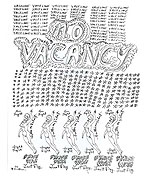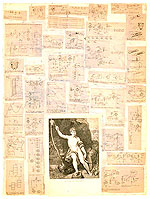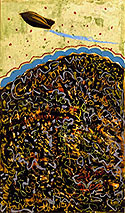| |
"Robert Smithson: Language to be Looked at
and/or Things to be Read, Drawings from 1962-63"
James Cohan Gallery
February 5 - March 4, 2000
A spate of exhibitions featuring sculptors'
drawings demonstrates the fluidity with which artists worked across
media during the 1960s and 1970s. Recent group and monographic shows
highlighting works on paper by Gordon Matta-Clark, Eva Hesse, Sol
Lewitt, Nancy Holt and Robert Smithson attest to both the richness
of this material and the current appetite for it.1
No one in this community of artists exploited the permeable boundaries
between two and three dimensions, or dialectical relationships between
words, images and objects, as thoroughly as Robert Smithson.
 |
|
|
For this reason it is fortunate that "Robert
Smithson: Language to be Looked at and/or Things to be Red, Drawings
from 1962-63," held this spring at James Cohan Gallery, focused
on Smithson's early works on paper. It served as an important complement
to the shows mentioned above, some of which dealt with Smithson's
better-known work in minimal and process-oriented idioms from the
later 1960s. The Cohan Gallery show reopens provocative questions
posed in the last decade by scholars including Caroline Jones and
Eugenie Tsai. How should we read Smithson's text-emblazoned drawings
and collages from the early 1960s? And what relationship might this
work (which was later rejected by Smithson and critics alike as
juvenilia) have to his tremendously influential production during
the later 1960s and early 1970s? 2
A majority of the works displayed in the Cohan
Gallery show are free hand ink drawings that foreground an interplay
between text and cartoon-like images. The simultaneously hieroglyphic,
pictographic, and phonetic possibilities of words as material are
explored in works such as No Vacancy, 1962. The title phrase
of this drawing is rendered in an overwrought schoolboy script,
while the tawdry pleasures imagined within are described by the
word "VASELINE" exclaimed 52 times on the top third of the sheet.
Compulsive repetition as ritual and ornament play out in a grid
of 11 x 26 5-pointed stars, and in the form of an expressionless
female nude, outlined by the text "butter on velvet," repeated five
times below. Smithson's proclivity for marrying banal and apocalyptic
themes during this period is demonstrated by the incantation "Price
War Last Day" inscribed like a doomsday pediment across the bottom
of the page.
 |
|
|
Of the 31 works on paper included in the exhibition,
six of the densest and most complex pieces are collages. Tension
between center and periphery, a dynamic later developed more rigorously
in Smithson's theory of site and nonsite, is humorously explored
in St. John in the Desert, c. 1961-63. At multiple removes
from its source, the central image is a cut-out mechanical reproduction
of an etching after Raphael, representing a scantily clad boy in
leopard skin. This winsome St. John is surrounded by diagrams of
cathode resistors, audio output recorders, and various types of
circuits apparently clipped from a user's manual. The text in these
diagrams is rife with organic/mechanical metaphor -- "good fuse,
bad fuse" -- and advice of dubious value to St. John -- "how we
put a magnetic field on tape." Technical drawings engulf Raphael's
mage like improbable marginalia; clearly neither can explain the
other, yet in their absurdity both the saint and the gadgets are
presented as objects of desire.
The exhibition title, "Language to be Looked
at and/or Things to be Read," was lifted from a Dwan Gallery press
release drafted by Smithson (under the pseudonym Eton Corrasable)
in 1967. The drawing that accompanied that press release (A Heap
of Language, 1966) was not included in the Cohan Gallery show,
but Smithson's published work from that period was represented by
the inclusion of two magazine articles displayed in a vitrine.3
Both of these works, as examples of Smithson's polemic ruminations
on art and history, reward sustained attention beyond the
 |
|
|
scope of this review. However, the most persuasive
argument in the show for connections between Smithson's early drawings
and his later three-dimensional works is perhaps to be found in another
collage, Conch Shell Spaceship and Word Land Mass, 1961-63.
Three quarters of this vertically-oriented work is populated with
a proliferation of nouns and proper names -- "Gorgon," "OHARA," "things,"
"Lyme" -- scrawled in crayon which has been overwashed with black
gouache. Figure and ground struggle for dominance in this "word land
mass." The text, rendered in oil crayon, repels the water-based gouache,
but where the crayon line is thin it is overwhelmed by dark painted
pigment so that the text is in turn sublimated. The inversion of figure
and ground, the elision of words and matter (or the emergence of words
as matter), and the science fiction elements of Conch Shell Spaceship
and Word Land Mass are themes fruitfully explored in Smithson's
later work, such as Spiral Jetty, 1970. Variously realized
as a monumental earthwork, an experimental film, a parodic essay,
and sheaves of drawings ranging from rough concept sketches to carefully
scaled engineering plans, Spiral Jetty may seem too elaborate
a project to compare to this humble collage. Yet, rather than positing
a simple causal relationship between the drawings and collages from
1961-63 and works in three dimensions from 1966-1973, the works in
this exhibition provide an opportunity to examine Smithson's preliminary
forays into a thicket of complex ideas. While affinities between the
early collages and drawings and Smithson's later projects are intriguing,
these works even more telling as evidence of what he left behind in
the construction of his mature, self-described oeuvre.
References>>
Author's Bio>>
|
|